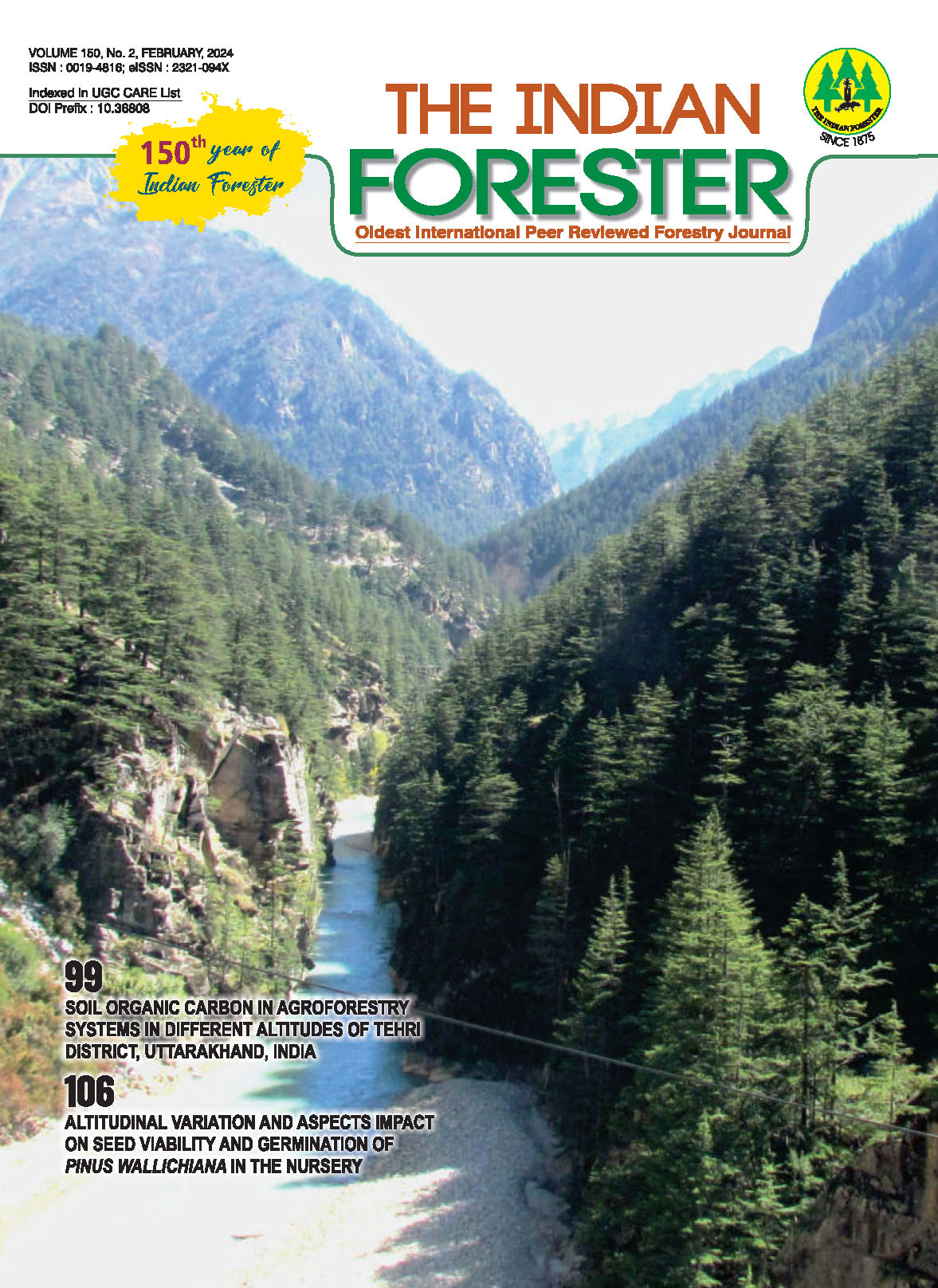Radial Variation in Growth Ring Widths with Reference to Age from Juvenile Wood to Mature Wood of Five Selected Indian Woods
DOI:
https://doi.org/10.36808/if/2024/v150i2/169502Keywords:
Juvenile Wood, Mature Wood, Radial Variation, Growth Rings, Growth Rate.Abstract
Trees are diverse in terms of growth rate. From fastest growing tree species such as Poplar to slowest growing tree species like white Cedar; growth rate varies widely among trees. Furthermore, the growth rate differs within a tree in juvenile wood and mature wood. Cambium and favorable climatic conditions are the two major factors responsible for the growth of a tree. The paper focuses on the growth rate or radial variation in growth ring widths from pith to bark of five wooden discs of Indian woods. Among the studied samples; Cedrela microcarpa was found to be fastest growing tree species with an average annual growth of 5.01 mm followed by Tectona grandis and Ulmus wallachiana with an average annual growth of 3.37 mm and 3.05 mm respectively. Least average growth was found for Robinia pseudoacacia (2.19 mm) and Tsuga brunoniana (2.36 mm). Correlation between ring width and age of the tree has also been developed. Accordingly, a weak negative correlation exists between two variables for two discs (Tectona grandis and Robinia pseudoacacia) while there exist no relation or very weak relation between ring width and age for another three discs i.e., Cedrela microcarpa, Tsuga brunoniana and Ulmus wallichiana. The cambial activity could be declared higher in initial phase of tree and ring growth was observed more or less environmental dependent.References
Abdel-Gadir Y. and Krahmer R. (1993). Estimating the age of demarcation of juvenile and mature wood in Douglas fir. Wood Fiber Science, 25(3): 242-249.
Alteyrac E.J., Clotier A. and Zhang S.Y. (2006). Characterization of juvenile wood to mature wood transition age in black spruce (Picea mariana Mill.) at different stand density and sampling heights. Wood Sci. Technol., 40: 124-138.
Baral S., Gaire N., Aryal S. and Pandey M. (2019). Growth ring measurements of Shorea robusta reveal responses to climatic variation. Forests, 10: 466.
Benson P.H. (1957). Juvenile wood in conifers (Report No 2094), U.S. Department of Agriculture, Forest Products Laboratory, Madison, WI.
Bhat M.K., Priya B. P. and Rugmini P. (2001). Characterization of juvenile wood in teak. Wood Science and Technology, 34: 517-532.
Bhattacharyya A., Yadav R.R., Borgaonkar P.H. and Pant G.B. (1992). Growth- ring analysis of Indian tropical trees: dendroclimatic potential. Current Science, 62(11): 736-740.
Bissing R.D. (1982). Variation in Qualitative Anatomical Features of the Xylem of Selected Dicotyledonous Woods in Relation to Water Availability. Bulletin of the Torrey Botanical Club, 109: 371-384.
Blasing T.J. and Puvik P.N. (1983). Filtering the effects of competition on tree ring width series. Tree-Ring Bulletin, 43: 19-30.
Brauning A., Ridder D. Maaike., Zafirov N., Gonzalez G. Ignacio., Dimitrov P. Dimitar. and Gartner H. (2016). Tree ring features: Indicators of extreme event impacts. IAWA Journal, 37(2): 206-231 pp.
Carlquist S. (2001). Comparative Wood Anatomy. Systematic, Ecological, and Evolutionary Aspects of Dicotyledon Wood. Springer, 2-35 pp.
Edwin H. and Lusayo M. (2018). Within and Between – Tree Variation in Growth Ring Width of Pinus oocarpa Wood. Int J Environ Sci Nat Res., 13(1): 555851.
Edwin H., Lusayo M. and Edward M. (2018). Within and Between-Tree Variation in Growth Ring Width of Pinus oocarpa Wood. International Journal of Environmental Sciences & Natural Resources. 13. 01-06. DOI: 10.19080/IJESNR.2018.13.555854.
Izekor D.N., Fuwape J.A. and Oluyege A.O. (2010). Effects of density on variations in the mechanical properties of plantation grown Tectona grandis wood. Archives of Applied Science Research, 2(6): 113-120.
Lewark S. (1986). Anatomical and physical differences between juvenile wood and adult wood. IUFRO World Congress, Division-5. 272-281.
McDonald E. and Hubert J. (2002). A review of the effects of silviculture on timber quality of Sitka spruce. Forestry, 75(2): 107-138.
Moore J.R. and Cown D.J. (2017). Core wood (juvenile wood) and its impact on wood utilisation. Curr For Rep., 3(2): 107–118.
Novruzova Z.A. (1968). The Water-Conducting System of Trees and Shrubs in Relation to Ecology. Izd. AN Azerb. SSR, Baku, 230 pp.
Oyelere A.T., Riki J.T.B., Adeyemo S.M., Majekobaje A.R. and Oluwadare A.O. (2019). Radial and axial variation in ring width of caribbean pine (Pinus caribaea Morelet) in afaka plantation, Kaduna state, Nigeria. Journal of Research in Forestry, Wildlife & Environment Vol. 11(3): 81-89
Palermo M. de P.G., Latorraca F. de V.J., Carvalho de M.A., Calonego W.F. and Severo D.T.E. (2015). Anatomical properties of Eucalyptus grandis wood and transition age between the juvenile and mature woods. Eur. J. Wood Prod.
Panshin A.J. and de Zeeuw C. (1980). Textbook of wood technology. McGraw-Hill Book Co., New York, 772 pp.
Wheeler E.A., Baas P. and Gasson P.E. (eds.) (1989). IAWAlist of microscopic features for hardwood identification. IAWA Journal, 10(3): 219-232.
Downloads
Downloads
Additional Files
Published
How to Cite
Issue
Section
License
Unless otherwise stated, copyright or similar rights in all materials presented on the site, including graphical images, are owned by Indian Forester.





